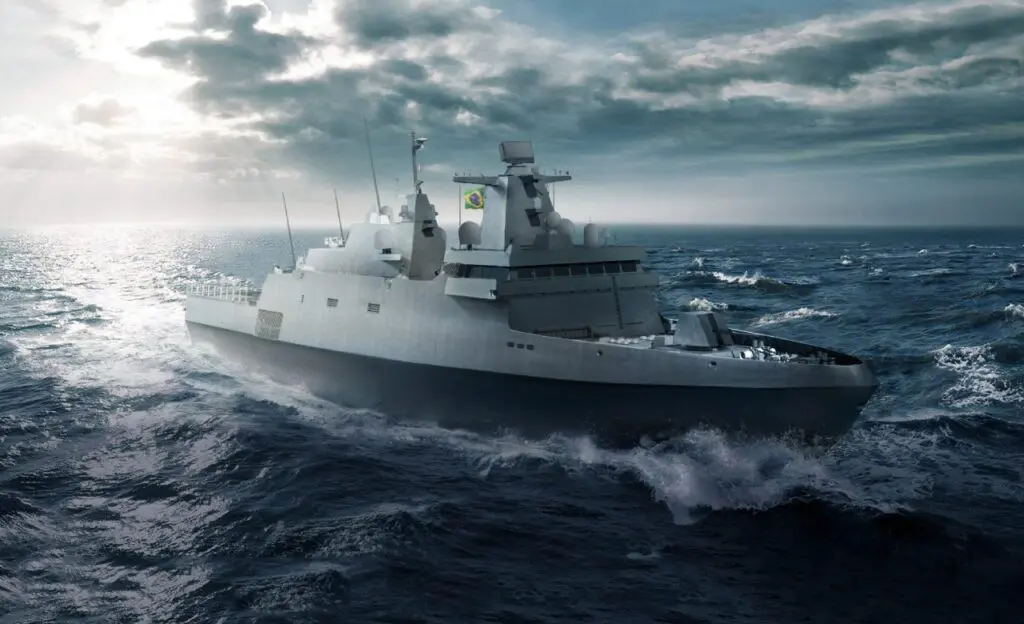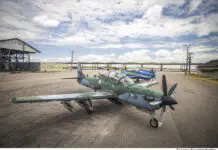Throughout the last decade and part of the current one, the Armed Forces of South America have consolidated various naval construction projects, which have progressed from mere consideration in official documents to being a full-fledged reality. In recent years, it has become normal to hear about the developments in shipyards located in Brazil, Chile, Peru, and more recently, Colombia, which are advancing in providing their respective navies with larger and more complex vessels, as well as other services related to maintenance, support, and modernization of Surface and Submarine Fleets.
This reality contrasts with the current situation in other countries, such as Argentina, which to this day cannot make the leap and regain capabilities that in the past made the country one of the regional leaders in naval construction. In the following lines, we will briefly review the main naval construction projects destined for the Armed Forces of the region.
Brazil
PROSUB Submarines
There is no doubt that one of the most ambitious programs in the region over the last decade has been the PROSUB of the Brazilian Navy. Stemming from a strategic partnership with France, its goal was to construct four new attack submarines of the Riachuelo class (based on the Scorpene class of Naval Group), and looking ahead to the next decade, a unit equipped with nuclear propulsion named Álvaro Alberto.

The construction of a new submarine class, intended to replace the Type 209/1400 (Tupi and Tikuna class), required significant investments in infrastructure, not only concentrating on the manufacturing of the units but also on the future facilities serving as the base for the new Riachuelo class. These efforts materialized in the new Itaguaí Naval Complex located in Rio de Janeiro, which has been the headquarters of the Brazilian Navy’s Submarine Force Command since 2021.
According to recent announcements, the Brazilian Navy has already incorporated two units of the class into service, while progressing with the retirement of units of the Type 209 class. Specifically, these are the commissioning of the new Riachuelo (S-40) and Humaitá (S-41), which have successfully completed their sea trials and acceptance. The remaining two submarines, Tonelero (S-42) and Angostura (S-43), are at various stages of completion. Finally, in this section, albeit surrounded by great secrecy, the neighboring country is advancing in the development of test reactors that will power the future Álvaro Alberto, which is expected to enter service during the next decade.
Tamandaré-class Frigates



Designed as replacements for the Niterói-class units, the Tamandaré-class frigates are another high-profile program of the Brazilian Navy aimed at renewing its surface fleet and escorts. Arising from the partnership with the German shipyard Thyssenkrupp, the local construction of four units is envisaged, with an option for two additional units, to be delivered between 2025 and 2029. Among the latest reported developments were advances in the construction of the first unit “Tamandaré (F-200)”, which is scheduled to be launched in the middle of the current year. The second unit under construction, “Jeronimo de Albuquerque (F-201)”, began its fabrication last November as part of the ceremony for the cutting of the first naval steel plate.
Polar Ship “Almirante Saldanha”
Another ongoing program, given the increasing importance of Antarctica, is the construction of a new Polar Ship for the Brazilian Navy. Although it does not have the profile of submarine and frigate programs, the local construction of a unit of this kind demonstrates Brazil’s commitment to strengthening its capabilities to support and sustain its presence in the White Continent.


As of today, the “Almirante Saldanha” is being built in local shipyards, with the ceremony for cutting the first steel plate taking place in 2023, and its completion projected for 2025. This ship will have an approximate length of 103 meters, a hangar for two medium-sized helicopters, a range of 70 days, and capacity to accommodate a crew of 95 people, including 26 researchers.
Chile
Polar Ship Almirante Viel
December 2022 was not just another month for Chile’s naval industry. These dates marked one of its most significant milestones to date with the launch of the polar ship Almirante Viel, built as part of the Antarctic Project I of the Chilean Navy. The 10,500-ton displacement vessel was constructed at the ASMAR shipyards, which have been establishing themselves as one of the benchmarks in the region’s naval industry.

The construction of the Almirante Viel, initiated in 2018, involved an investment of USD 210 million, engaging 800 workers from the ASMAR shipyard and thousands more in industries associated with the project. According to official announcements from the Chilean Ministry of Defense, it is planned that the unit will be delivered to the Navy during the current year, although no further details have been provided since its launch.
As for its capabilities, it will have “space to transport 19 containers of 20 feet, 400 m3 of fuel cargo, pallet cargo, and will be equipped with a self-propelled boat and cranes with a lifting capacity of 25 tons. To carry out search and rescue tasks (SAR operations), it will have the capacity to operate with two medium helicopters and two rescue boats“, as detailed by ASMAR.
Multipurpose Ships Escotillón IV Project
As part of the National Continuous Naval Construction Plan, the ASMAR shipyard has, among its other ongoing programs, the construction of new multipurpose ships under the Escotillón IV Project. This project entails the manufacture of a total of four multipurpose ships to replace the AP-41 Aquiles and the Batral-class barges of the Chilean Navy. These future units will be assigned to the Amphibious Expeditionary Brigade (BAE) of the Marine Corps.



For these new ships, the Chilean Navy selected the design from Vard Marine shipyard, belonging to the Fincantieri group. The same company has provided the design and technical support for the construction of the future Antarctic Project 1 Polar Ship. Each of the multipurpose ships will have a displacement of 7,987 tons, a length of 110 meters, and a beam of 21.8 meters, with the capacity to transport up to 250 personnel. The projected range is around 7,000 nautical miles.
Regarding the delivery dates of the first unit, which is currently under construction, it has been projected to be launched during the current year of 2024, with the aim of continuing with the completion works for its provision to the Chilean Navy. However, no further official details have been provided on this matter.
Peru
Type 209 Submarine Modernization
One of the most important capacity recovery programs undertaken by Peru is the modernization of its Type 209 submarine fleet, carried out locally at the SIMA shipyards. This process, which has the first completed unit, B.A.P. Chipana, undergoing tests, has involved significant investments in infrastructure and human resources.


The work carried out, including the cutting of the hull for the installation of the new MTU 12V493 AZ80 GA31L engines and the replacement of its 480 batteries, received technical assistance and supervision from the German shipyard Thyssen Krupp Marine Systems (TKMS). Additionally, a new firing and combat system called “Kallpa” was installed, along with new periscopes and the capability of launching Exocet SM-39 anti-ship missiles.
Among the latest developments, the launching of the aforementioned B.A.P. Chipana can be highlighted, which is undergoing stability tests awaiting its first voyage; meanwhile, the B.A.P. Antofagasta is undergoing similar work, with its hull currently being cut into different sections to install the new MTU engines and sets of renewed systems and batteries.
Makassar-class Multipurpose Ships
Parallel to the modernization of its Type 209 submarines, the SIMA shipyard is also progressing with the construction of its second LPD-type ship for the Peruvian Navy. Named B.A.P. Paita, the unit is in an advanced stage of completion, with recent placement of construction blocks forming part of the ship’s superstructure.



Its construction, along with its twin B.A.P. Pisco, arises from the partnership between the Peruvian shipyard and the South Korean naval company Daesun Shipbuilding & Engineering; the first milestone being the launch and commissioning of this unit in 2018. One of the latest developments in the operational career of this ship is its participation in various international exercises, such as UNITAS, as well as the transport of Sea King helicopters symbolically transferred by Spain to Peru.
Colombia
Driven by COTECMAR and associated companies, Colombia’s naval industry has been steadily progressing to equip the Colombian Navy with renewed river, patrol, scientific, and soon-to-be combat vessels. This is evidenced by the recent delivery and commissioning of the oceanographic vessel Simón Bolívar, which has already completed its first expedition to Antarctica.
One of the keys to achieving this milestone, being the first ship of its class built locally in Colombia, is the partnership with the Dutch shipyard Damen, which provided the base design of the Simón Bolívar and technical consultancy as a result of agreements reached in 2020.


This fruitful partnership will soon be strengthened with the selection of Damen’s design for the construction of the new multipurpose frigates of the Colombian Navy. As announced in 2022, the DAMEN design was selected to advance in the construction at COTECMAR of the future replacement for the current Almirante Padilla-class frigates.
Provisionally named “Strategic Surface Platform,” the Navy of the Republic of Colombia has reportedly selected the frigate design of the SIGMA class developed by Damen. More precisely, the frigate 10514. Among its characteristics are a length of 105 meters, a beam of 14 meters, with a displacement of 2,500 tons. According to Damen, the frigates can perform anti-surface, anti-submarine, and anti-aircraft warfare missions.
Meanwhile in Argentina…
The brief list presented in the previous paragraphs only provides a glimpse of the regional reality that serves as a mirror to Argentina. While official documents and announcements emphasize the importance of the local naval industry to equip the Navy with sufficient means to safeguard the “Blue Pampa,” the declarations of Political Power are not accompanied by the necessary resources and will to valorize national shipyards.
To date, the “main” projects of the Argentine naval complex focus on the construction of small vessels, with delivery schedules that cannot be met due to various factors. In this regard, Tandanor has not launched any of the tugboats intended by the Argentine Navy, with the construction of two units listed. Meanwhile, Astillero Río Santiago only now, after nearly a decade of back and forth, and various setbacks, can begin sea trials of its Cadet Training Launches (LICA).


Other ongoing projects include the recovery of surface units, such as the MEKO 140 corvettes and the ARA Patagonia logistics support ship. Furthermore, there have been no agreements or contracts listed to allow for an association with international companies to commence the construction of larger tonnage units, remaining only in the stage of exploring proposals or conceptual design phases.
A striking example is the construction of a Polar Ship for the Argentine Navy, which is in an embryonic phase, at best, being in the engineering stage with the Finnish firm AKER. Although the 2024 National Budget Projects mention the construction of this type of vessel, allocating an investment of USD 195,000,000 with a three-year amortization period, updates on the progress or lack thereof of the project have been scarce, with almost two years having passed since the contract between Tandanor and Aker was signed for the development of the Basic Engineering and Capabilities of the Polar Ship.

Without support or political will, but with an extensive bibliography of documents, resolutions, and National Defense Policy Directives where the importance of the maritime littoral is discussed, such as its defense and protection, the declarations of Political Power are just hollow words in the face of the pressing reality of continuous decline and loss of capacities experienced by the Argentine Navy. In the current state of affairs, the local naval industry lacks the productive capacities to provide the country with what it needs for its defense. Comparisons are odious, especially when it is not necessary to compare oneself with the great powers, but rather with our neighbors, who are translating their intentions to protect and guard their maritime spaces into concrete actions and deeds.
*Photographs used for illustration purposes.
You may also like: The rapprochement between Argentina and the U.S. could be reflected in a greater exchange between their special operations units










